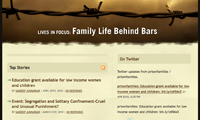Robust and frequent content begets more content, but all is for naught if the community doesn’t pay attention. Sites not only need to whet the interest of potential contributors, they also have to get the community at large to participate.
The sites that have invited community participation in multiple ways show the most promise. Engagement doesn’t always have to come in the form of full-blown stories, although original content delivers the greatest added value. Community involvement can take the form of photos, videos or links to other stories in the state or region. It can be community announcements or current meeting agendas. It can be an historical photo or article from the public library. Or it can take the form of comments.

Engagement doesn’t always have to come in the form of full-blown stories.
Engagement can also be entirely creative. Family Life Behind Bars has moved away from having CUNY students go out and report stories and instead sought to become more collaborative with its community - people who have family members in prison.
“My [story] ideas are not as rich as work that comes out of collaborative work,” said founder Sandeep Junnarkar. So he has sought engagement by inviting art competitions and enabling people to leave questions via voicemail. The audio then appears on the website. One woman asked for advice on how to deal with a family member dying of cancer in prison, which led to a column of tips. The site also runsInternet radio shows. Sometimes he throws up a Google form and asks his community to weigh in. With prison telephone calls costing as much as $3 for a connection fee and 60 cents a minute, he put up a survey asking: “What did you sacrifice to accept these collect calls?”
“We got a great response,” he said.
The Forum has addressed the community’s rich artistic culture by publishingcreative writing.
New Era News has invited politicians to be guest bloggers.
The Twin Cities Daily Planet allows rants in its Free Speech Zone for community members who don’t want to report journalistic stories.
Grosse Pointe Today updates a Google map weekly with police blotter news.
The Austin Bulldog posts copies of public documents it acquires in reporting its investigative stories for readers to examine themselves.
Great Lakes Echo looks to engage its community with satellite images that track things like sediment runoff or algae blooms in the lakes.
If anything, New Voices projects introduced some storytelling techniques that mainstream journalists would do well to heed.
Vet Venue has helped 150 veterans find jobs but learned that vets didn’t want to share any information that might make them seem unemployable, so the site has focused on job resources.
Despite often-aired concerns about whether contributions from citizen journalists could be accurate and ethical, the New Voices projects did not have difficulties reporting responsible stories. In only one instance did J-Lab intervene with content concerns.
If anything, New Voices projects introduced some storytelling techniques that mainstream journalists would do well to heed: There was, for instance, a willingness to report not just what people said in a meeting, but also clarify what they meant to say. And more explanatory, instead of conflict-framed, coverage of issues has won appreciation from readers.
